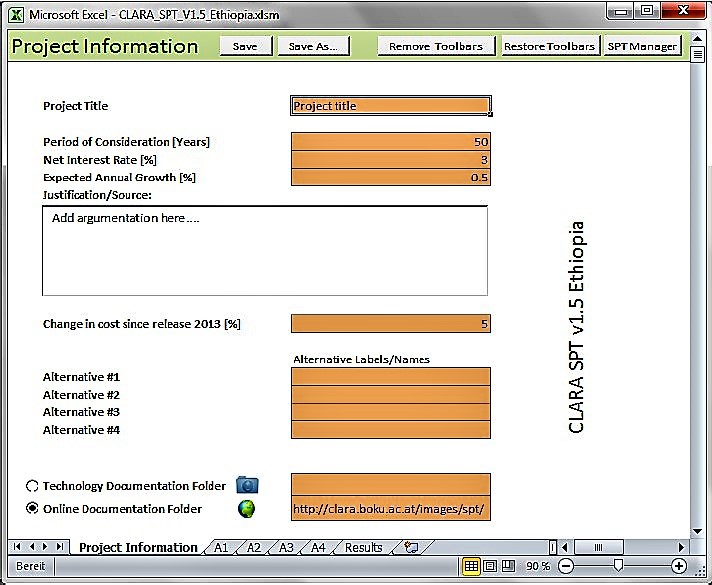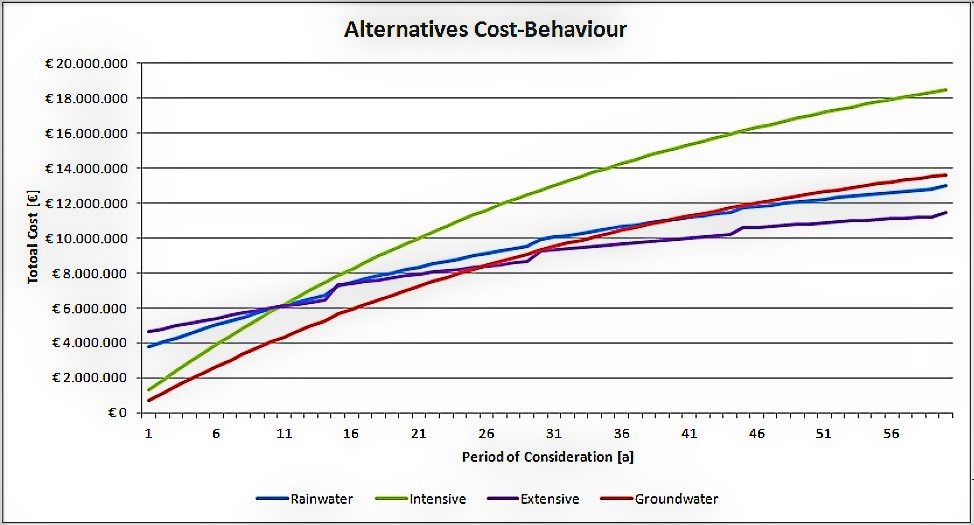Executive Summary
The CLARA Simplified Planning Tool (SPT) provides a tool to local planners, which not only allows but even encourages the comparison of fundamentally different water and sanitation systems at a very early planning stage. Using the SPT requires a limited amount of effort from the planner and thus results in minimal costs for the client.
Introduction
The CLARA Simplified Planning Tool (SPT) aims to support local planners to find the best solution for water supply and sanitation interventions. Simplified in the sense that the software tool is based on numbers of assumptions, which allow the planner to use the SPT with a limited amount of data available at the pre-planning phase of a project.

The SPT compares full costs (investment, operation and maintenance, and re-investment costs) of various alternatives of water supply and sanitation systems. Environmental, social and health aspects are not considered explicitly: it is assumed that these aspects are already considered in the framework conditions, i.e. all systems fulfil the legal requirements, benefit environment and health and are socially appropriate. With this assumption, the comparison of alternatives can justifiably be reduced to comparing the costs. Net present values of all costs are calculated and used for comparison.

The user of the CLARA simplified planning tool - the planner - is responsible for developing appropriate alternative solutions. Technologies are grouped in functional groups as defined in the Sustainable Sanitation and Water Management Loop. These functional groups include: Water sources, Water purification, Water distribution, Water use, Waste collection and transport, Waste treatment, and Reuse and Recharge.
Technologies in the functional groups have to be compiled to systems. Examples of combinations of technologies to meet specific requirements in the functional groups "Waste collection" and "Waste treatment" are shown in the user manual (CASIELLES RESTOY et al., 2014).
Cost functions that relate costs to input parameters have been developed for each technology implemented in the CLARA SPT. Therefore for each technology standard designs have been defined, designs have been made for several sizes, and the costs have been calculated from Bills of Quantities developed for these design sizes.
"Technology description" provided with the CLARA SPT include the main assumptions made for developing the costs functions and include: a short description of the technology, design assumptions, input data (in the SPT, the validity range of the cost function, the assumed lifespan of the technology and its components, and the assumptions for calculating O&M costs).
The CLARA SPT has been adapted to the different requirements of the African CLARA partner countries, i.e. Burkina Faso, Ethiopia, Kenya, Morocco and South Africa. Specific design requirements and unit prices have been considered for these countries before country-specific cost functions were developed. The country specific versions of the CLARA SPT have been prepared and tested during the planning process with pilot communities in the 5 African CLARA countries.
The country-specific CLARA SPT versions can be downloaded as single zip-files. Each of them comprises:
- The SPT file itself (version 1.5 of the CLARA SPT is implemented in Microsoft Excel®, MS Excel® 2010 is required)
- The user manual
- The "Technology descriptions" (see the appendix 1, p.27 of the user manual)
Acknowledgements
The work was carried out within the project CLARA (Capacity-Linked water supply and sanitation improvement for Africa’s peri-urban and Rural Areas; Contract # 265676; duration: 1.3.2011 – 28.2.2014), a Collaborative Project funded within the EC 7th Framework Programme, Theme "Environment (including Climate Change)".
The CLARA SPT shall be used to compare the real costs of various alternatives of water supply and sanitation systems (e.g. comparing water-borne and dry sanitation systems) in the pre-planning phase.
The tool cannot be used to compare:
- alternative solutions that do not provide the same service (e.g. comparing a solution that fulfils the legal requirements with e.g. the solution "no sanitation facilities");
- costs of single technologies during detailed planning;
- environmental, social and health impacts (as they are considered to be fulfilled when the framework conditions are met), and
- a solution that fulfils legal requirements with e.g. the solution "no sanitation facilities" as these 2 alternatives do not have the same impact. However, the tool can be used to compare.
CLARA Simplified Planning Tool v1.5
This document presents the user manual for the CLARA Simplified Planning Tool (SPT). It is not aimed to provide a guide on the planning process of water supply and sanitation systems, it just describes the use of the CLARA SPT.
CASIELLES RESTOY, R. LECHNER, M. LANGERGRABER, G. (2014): CLARA Simplified Planning Tool v1.5. User Manual. [Accessed: 03.02.2014] PDFCLARA Simplified Planning Tool v1.5
This document presents the user manual for the CLARA Simplified Planning Tool (SPT). It is not aimed to provide a guide on the planning process of water supply and sanitation systems, it just describes the use of the CLARA SPT.
CASIELLES RESTOY, R. LECHNER, M. LANGERGRABER, G. (2014): CLARA Simplified Planning Tool v1.5. User Manual. [Accessed: 03.02.2014] PDFCLARA Simplified Planning Tool v1.5 User Manual (French version)
This document presents the user manual for the CLARA Simplified Planning Tool (SPT) in French. It is not aimed to provide a guide on the planning process of water supply and sanitation systems, it just describes the use of the CLARA SPT.
CASIELLES RESTOY, R. LECHNER, M. LANGERGRABER, G. (2014): CLARA Simplified Planning Tool v1.5 User Manual (French version). [Accessed: 03.02.2014] PDF
